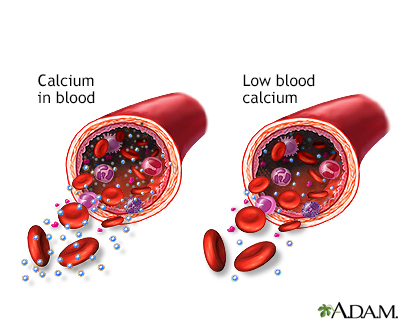Low calcium level - infants
Definition
Calcium is a mineral in the body. It is needed for strong bones and teeth. Calcium also helps the heart, nerves, muscles, and other body systems work well.
A low blood calcium level is called hypocalcemia. This article discusses low blood calcium level in infants.
Alternative Names
Hypocalcemia - infants
Causes
A healthy baby most often has very careful control of blood calcium level.
A low calcium level in the blood is more likely to occur in newborns, more commonly in those who were born too early (preemies). Common causes of hypocalcemia in a newborn include:
- Certain medicines
- Diabetes in the birth mother
- Episodes of very low oxygen levels
- Infection
- Stress caused by serious illness
There are also some rare illnesses that can lead to low calcium level. These include:
- DiGeorge syndrome, a genetic disorder.
- The parathyroid glands help control calcium use and removal by the body. Rarely, a child is born with underactive parathyroid glands.
Symptoms
Babies with hypocalcemia often have no symptoms. Sometimes, babies with low calcium levels are jittery or have tremors or twitching. Rarely, they have seizures.
These babies may also have a slow heart rate and low blood pressure.
Exams and Tests
Diagnosis is most often made when a blood test shows that the infant's calcium level is low.
Treatment
The baby may get extra calcium, if needed.
Outlook (Prognosis)
Problems with low calcium level in newborns or premature infants most often do not continue long-term.
Gallery

References
Doyle DA. Hormones and peptides of calcium homeostasis and bone metabolism. In: Kliegman RM, St. Geme JW, Blum NJ, Shah SS, Tasker RC, Wilson KM, eds. Nelson Textbook of Pediatrics. 21st ed. Philadelphia, PA: Elsevier; 2020:chap 588.
Escobar O, Gurtunca N, Viswanathan P, Witchel SF. Pediatric endocrinology. In: Zitelli BJ, McIntire SC, Nowalk AJ, Garrison J, eds. Zitelli and Davis' Atlas of Pediatric Physical Diagnosis. 8th ed. Philadelphia, PA: Elsevier; 2023:chap 9.